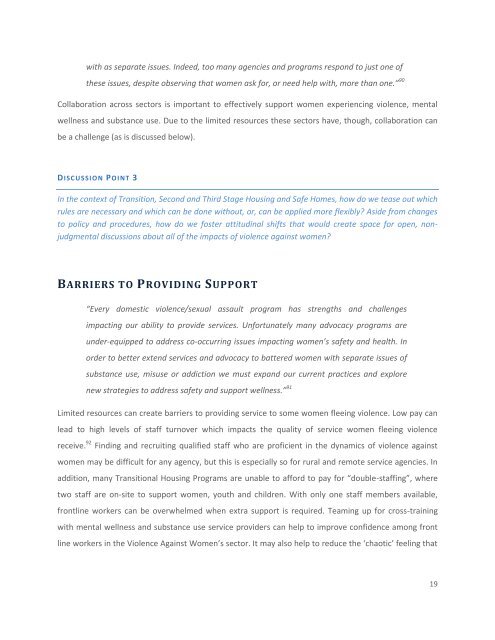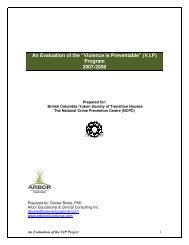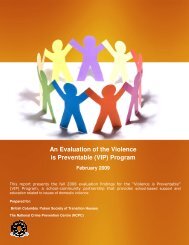reducing barriers to support - BC Society of Transition Houses
reducing barriers to support - BC Society of Transition Houses
reducing barriers to support - BC Society of Transition Houses
You also want an ePaper? Increase the reach of your titles
YUMPU automatically turns print PDFs into web optimized ePapers that Google loves.
with as separate issues. Indeed, <strong>to</strong>o many agencies and programs respond <strong>to</strong> just one <strong>of</strong><br />
these issues, despite observing that women ask for, or need help with, more than one.” 90<br />
Collaboration across sec<strong>to</strong>rs is important <strong>to</strong> effectively <strong>support</strong> women experiencing violence, mental<br />
wellness and substance use. Due <strong>to</strong> the limited resources these sec<strong>to</strong>rs have, though, collaboration can<br />
be a challenge (as is discussed below).<br />
DISC USSI ON POINT 3<br />
In the context <strong>of</strong> <strong>Transition</strong>, Second and Third Stage Housing and Safe Homes, how do we tease out which<br />
rules are necessary and which can be done without, or, can be applied more flexibly Aside from changes<br />
<strong>to</strong> policy and procedures, how do we foster attitudinal shifts that would create space for open, nonjudgmental<br />
discussions about all <strong>of</strong> the impacts <strong>of</strong> violence against women<br />
BARRIERS TO PROVIDING SUPPORT<br />
“Every domestic violence/sexual assault program has strengths and challenges<br />
impacting our ability <strong>to</strong> provide services. Unfortunately many advocacy programs are<br />
under-equipped <strong>to</strong> address co-occurring issues impacting women’s safety and health. In<br />
order <strong>to</strong> better extend services and advocacy <strong>to</strong> battered women with separate issues <strong>of</strong><br />
substance use, misuse or addiction we must expand our current practices and explore<br />
new strategies <strong>to</strong> address safety and <strong>support</strong> wellness.” 91<br />
Limited resources can create <strong>barriers</strong> <strong>to</strong> providing service <strong>to</strong> some women fleeing violence. Low pay can<br />
lead <strong>to</strong> high levels <strong>of</strong> staff turnover which impacts the quality <strong>of</strong> service women fleeing violence<br />
receive. 92 Finding and recruiting qualified staff who are pr<strong>of</strong>icient in the dynamics <strong>of</strong> violence against<br />
women may be difficult for any agency, but this is especially so for rural and remote service agencies. In<br />
addition, many <strong>Transition</strong>al Housing Programs are unable <strong>to</strong> afford <strong>to</strong> pay for “double-staffing”, where<br />
two staff are on-site <strong>to</strong> <strong>support</strong> women, youth and children. With only one staff members available,<br />
frontline workers can be overwhelmed when extra <strong>support</strong> is required. Teaming up for cross-training<br />
with mental wellness and substance use service providers can help <strong>to</strong> improve confidence among front<br />
line workers in the Violence Against Women’s sec<strong>to</strong>r. It may also help <strong>to</strong> reduce the ‘chaotic’ feeling that<br />
19






